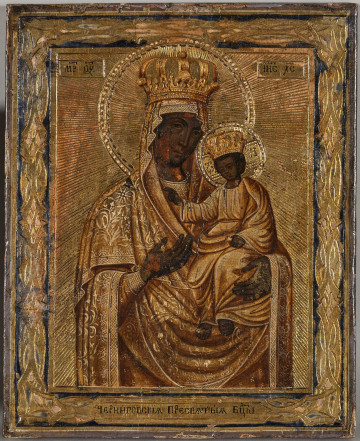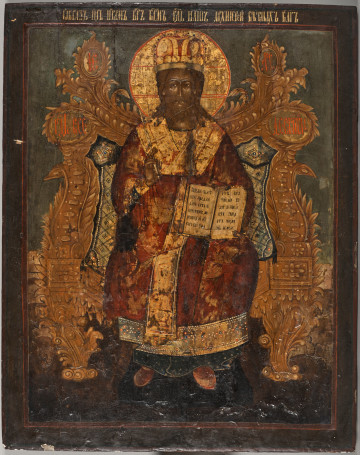
The Mother of God of Hodigitria
19th (?) century
Castle Museum in Łańcut
Part of the collection: Ikony
Crucifixion/Archangel Michael - crucifix The cross is one of the most important symbols of Christianity and holds a special place in the space of a temple. A cross with the depiction of the Crucified Saviour is placed within the sanctuary. In the territories of the old Rus, the cross located near the altar is commonly called 'zapriestolny', because the altar table, on which the transubstantiation of bread and wine into the Body and Blood of Christ takes place, is called a 'priestol'. The zapriestolny cross is placed on a base from which it can be taken out, e.g. for a procession. Because of this, it is sometimes called 'wynosny'. The displayed zapreistolny cross is a double-sided silhouette icon shaped like an eight-pointed cross. On its front, there is a depiction of the body of Christ nailed to the cross. On the reverse, there is a depiction of the Archangel Michael wearing armour. Since the time of the Trullan Council which took place in Constantinople in the years 691 - 692, in the Eastern Christian tradition it was forbidden to use the symbolic image of a lamb on the cross, decreeing the depiction of Christ in human form as the only admissable one. Among the Eastern Christians, depictions of the Crucifixion show the Glory of the Saviour, without too much emphasis on the elements of martyrdom and death. The body of Christ, who overcame death by the Sacrifice of the Cross, is not lax. The closed eyelids emphasise the reality of physical death but the blood flowing from the wounds testifies to the presence of the Holy Spirit in the tortured body. The feet of the Saviour, in accordance with the original visual tradition, are nailed separately with two nails to the foothold which constitutes the lower crossbeam. The Crucified Saviour is revered by the figures described in the Gospels: the two Marys, John the Theologian, and Longinus, who are shown on the ends of the central beam of the icon. Icons of the Crucifixion are frequently complemented by inscriptions and the Mandylion, see S.12864MŁ. The depiction of the Archangel Michael, the leader of the Heavenly Forces, is described under S.12767MŁ; S.12810MŁ. Teresa Bagińska-Żurawska https://orcid.org/0000-0002-9243-3967
Dimensions
height: 107 cm, width: 80.5 cm
Object type
Icons
Technique
gilding, tempera
Material
gold, tempera, wood
Origin / acquisition method
decyzja administracyjna
Creation time / dating
Creation / finding place
Owner
Castle Museum in Łańcut
Identification number
Location / status

19th (?) century
Castle Museum in Łańcut

1800 — 1850
Castle Museum in Łańcut

1800 — 1899
Castle Museum in Łańcut
DISCOVER this TOPIC
Museum of King Jan III's Palace at Wilanów
DISCOVER this PATH
Educational path